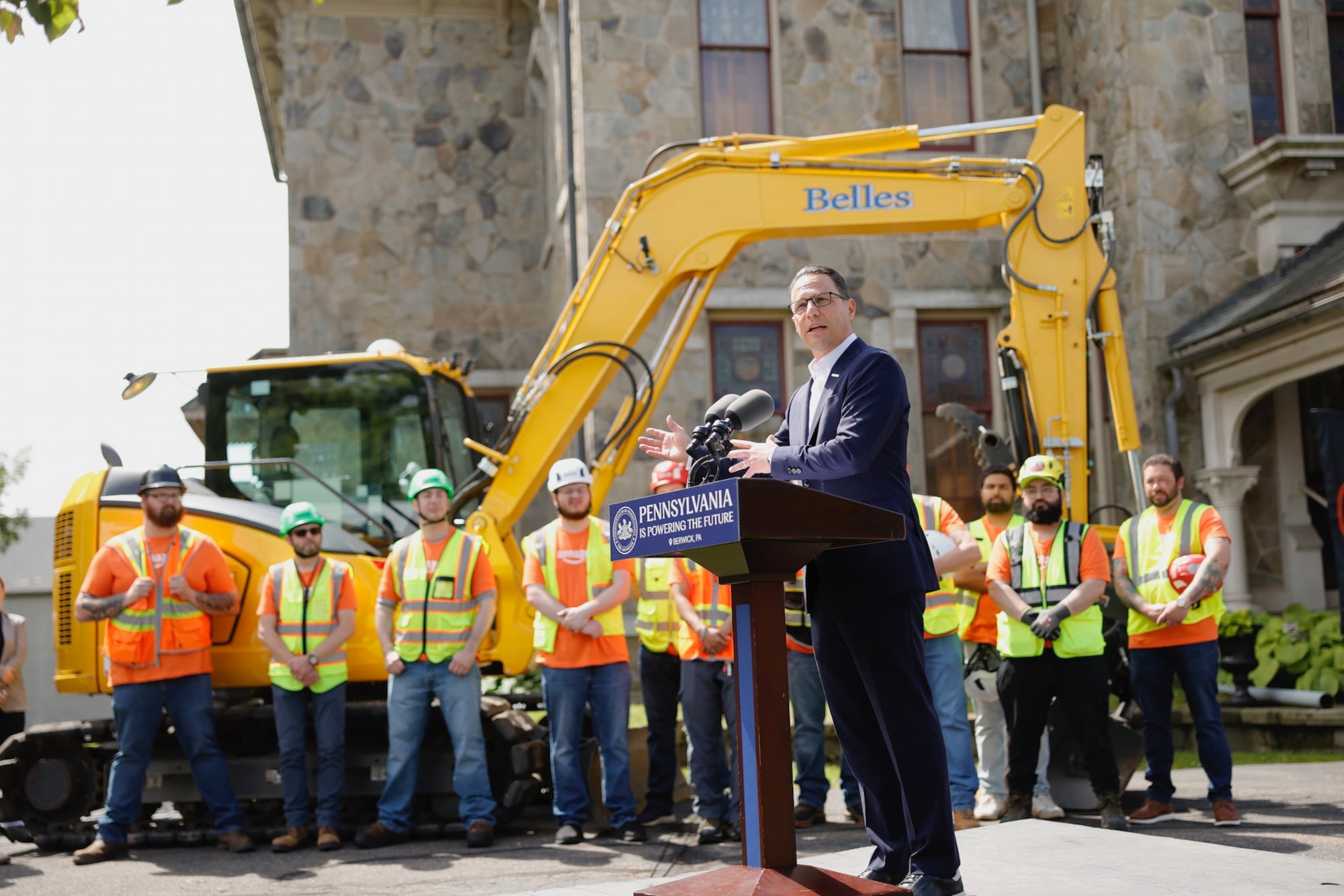Spotlight PA’s Stephen Caruso and Kate Huangpu’s story
Investigative and public service journalism produced by the independent, nonpartisan, nonprofit newsroom Spotlight PA holds Pennsylvania’s leaders accountable and promotes constructive change.Subscribe to our newsletters for free.
HARRISBURG According to state officials, Amazon’s $20 billion proposal to construct two data centers in Pennsylvania will create thousands of jobs over the next ten years and stimulate significant economic growth.
However, a number of important factors remain unclear, such as the center’s complete influence on electricity pricing and supply and the amount of tax money the state will lose to Amazon.
Pennsylvania has granted Amazon a sales tax exemption on essential equipment that could possibly cost the state millions of dollars that would otherwise be used for fundamental services like healthcare, education, and other necessities as part of a state statute to encourage the construction of data centers.
Democratic Governor Josh Shapiro’s spokesperson emphasized the benefits of the agreement in a statement, stating that it will bring in hundreds of millions of dollars in new tax income for state and municipal governments.
A data center is a large group of computer servers that process and store data, among other crucial tasks for the internet world. These centers are being constructed fast and often across the country as tools like artificial intelligence, which demands a lot of computing power, develop at a rapid pace.
To keep their servers cold, these facilities need a lot of water and electricity.
One, which is planned to be constructed in Salem Township, Luzerne County, will get some of its electricity from the Susquehanna Steam Electric Station, an existing nuclear power station. The electrical grid will supply the remainder of its power. The other will, at least initially, rely entirely on the grid for power and is intended to be an industrial park on the site of a former steel factory in Falls Township, Bucks County.
Amazon Web Services, the company’s cloud computing arm, might use the centers to launch additional development. Additionally, Amazon intends to construct a third data center north of Philadelphia, an Amazon executive told the Associated Press.
Here is what we know about these enormous enterprises, along with the benefits and drawbacks that go along with them.
What jobs are coming to Pennsylvania?
Department of Community & Economic Development Secretary Rick Siger stated that the two data centers will create thousands of construction jobs and at least 1,250 high-paying, high-tech jobs when Shapiro and his team announced the agreement in June.
These are fuzzy approximations. Data centers are infamous for requiring very little human labor to operate. Just 500 permanent jobs are expected to be created by Meta’s 2,250-acre data center in Louisiana after construction is complete.
The majority of permanent data center positions are in security and gardening, with a small number of technicians keeping an eye on the facility’ computers, according to Greg LeRoy, executive director of Good positions First, a Washington, D.C.-based watchdog that tracks state and local subsidies.
Major projects that come to the commonwealth are closely supervised by Rob Bair, president of the Pennsylvania Building and Construction Trades Council, an organization that represents tens of thousands of union workers. Amazon’s initial $20 billion spending commitment, he told Spotlight PA, likely ensures five to seven years of development on each site, including many decent, long-term construction employment.
He stated that although it is not a given, the corporation may decide to continue investing in the development of certain properties.
“I always advise everyone to plan for the best, but you never know,” Bair said. “They might get 12 buildings, and then suddenly there’s a shift in AI.”
He emphasized that, in his opinion, the initial investment is still very significant.
“That is a significant amount of economic activity for Pennsylvania,” he said.
How will the centers impact state finances?
The only direct financial commitment in the project will be $10 million from the state for specific workforce development initiatives, according to an email from Shapiro spokesperson Manuel Bonder.
According to Bonder, this will involve initiatives to develop new [career and technical education] courses, expand [vocational and technical training], and construct new training facilities at schools, community colleges, and union halls throughout Pennsylvania.
However, the actual cost to the state of the data centers is greater.
Although Pennsylvania did not present Amazon with a fresh, focused incentive package, the internet behemoth has already been granted a tax cut that the commonwealth offers to businesses that locate their data centers here.
Companies who invest at least $75 million in a data center and add at least 25 new jobs are exempt from state sales taxes when they buy servers, cooling systems, software, and other equipment. This is part of a state program that was put into law in 2016 and expanded in 2021.
According to the law, neither the seller nor the buyer must notify the state of the cost of exempt transactions. This implies that the precise price is unknown.
Nevertheless, the state makes budgetary forecasts for the lost tax revenue. However, those figures have changed based on the government making the cost projections.
The state is expected to lose $43 million in tax income to the data center credit in the next fiscal year, according to Shapiro’s most recent budget proposal. However, in his 2022 budget proposal, former Democratic Governor Tom Wolf projected the program’s expenditures over a number of years, estimating that it would likely cost close to $75 million in the fiscal year 2025–2026.
Even though the program expanded between Wolf’s and Shapiro’s estimates, this cost reduction still exists. In comparison to merely in 2022, 12 enterprises are certified to claim the exemption as of 2024, according to the state Department of Revenue.
According to Department of Revenue spokesperson Jeffrey Johnson, the initial estimate was lowered following early years of lower-than-anticipated use.
Similar financial incentives for data centers exist in dozens of other jurisdictions, which has resulted in a loss of hundreds of millions of dollars in tax revenue.
The criteria to create at least 25 jobs and spend at least $75 million on construction looked like a high hurdle when Pennsylvania’s tax exemption was originally established, according to LeRoy of Good Jobs originally. He claimed that there weren’t as many sizable data centers at the time.
However, as AI accelerates server farm development, more projects become eligible, raising the state’s expenses, he noted.
According to LeRoy, this industry is obviously self-sufficient. The general fund has suffered the largest loss at the state level, and you might wonder what that means: [money that isn’t being spent on] health care and education.
LeRoy stated that requiring recipients to disclose the true cost of the exemption is a fundamental good-government issue and that the legislature should, at the very least, make sure that they do so.
However, leaders don’t find those arguments very persuasive. State Senate Majority Leader Joe Pittman (R., Indiana) told reporters in June that he did not believe it was appropriate to interfere with the exemption.
He went on to say that data centers are a financial investment that might have gone elsewhere but is instead coming to Pennsylvania.
What about energy prices?
Governmental organizations and private research groups are forecasting large increases in energy demand as the number of data centers expands across the country.
A U.S.Department of Energyreport released last year found that data centers ate up about 4.4% of total electricity nationwide in 2023, and projected that number would increase to between 6.7% and 12% by 2028.
A Boston Consulting Group analysis found that the size of data centers, which are becoming larger, affects energy use. The firm estimated that the average data center currently consumes around 40 megawatts, and that the number will likely grow to 60 megawatts by 2028.
A gigawatt-sized center operating at peak demand would use an amount of energy comparable to a city of about 1.8 million people,CNBC noted in an analysis last year. That surpasses Philadelphia in size.
The size of the Amazon centers is still unknown, making it challenging to predict how much energy they will consume.
The Luzerne County facility will get part of its energy from an existing nuclear plant, thanks to a new power purchaseagreementbetween the generator, Talen Energy, and Amazon.
Bair, the Pennsylvania Building Trades president, expects the center to draw the rest of its power from the grid without disrupting reliability for nearby users. But, he added, if they re going to truly develop these over the long term in the campuses, they re going to need a substantial amount more.
Bair said the Bucks County data center, which plans to get all its energy from the electric grid, is in a different position because there was plenty of power from the supplier, [so] what we were taking off did not in any way, shape, or form lower grid reliability or grid capacity in that area.
However, if the Bucks data center keeps expanding, Amazon is planning to add generation so that the grid does stay reliable, he said.
Right now, where they re at, they re good. As they build that campus out, would I look for a future power source in that area? Yes.
All of the lingering questions about Amazon s plan create big concerns for lawmakers, as well as for advocates of clean energy and grid reliability.
State Sen. Gene Yaw (R., Lycoming) broadly supports the Amazon data centers but said he wants to be sure they won t overload the grid, which could lead to a rise in energy prices for Pennsylvanians.
What would best protect the interests of ordinary consumers, he said, is for data centers to build energy generators. Consumers would also benefit, he said, if data centers build new power plants using state tax credits such asa proposed credit for clean energy producersso at least part of that generated energy goes back to households.
State Rep. Rob Matzie (D., Beaver) said heplans to introduce legislationthat would create a regulatory framework for energy consumption by data centers, which he says will help ensure they don t overload the grid.
The Amazon deal is a big deal, obviously, but at the same time, we have to keep in mind, we don t want rolling blackouts, Matzie told Spotlight PA.
Jackson Morris, director of state power policy at the Natural Resources Defense Council, an environmental nonprofit, is more critical.
He said the deal between Talen Energy and Amazon to feed power from an existing nuclear facility into the data center essentially cannibalizes existing clean resources, as the zero-emission energy would be reserved for the data center instead of serving consumers.
Morris worries that the rising energy demand from data centers will not only drive up consumer prices but also lead to utility companies leaning more heavily on high-emission power sources, like natural gas and coal.
The reality is that the more demand you bring on without zero-emission supply, the more pollution we re going to have and the higher prices everyone s going to pay, Morris told Spotlight PA.
But Joe Dominguez, CEO of electricity producer Constellation Energy, argued that the demand to meet higher computing capacity must be met.
People often say, Look, all this power is going to data centers, and it s almost like there s an image in someone s mind that s going into a hole in the ground, Dominguez said at a recent news conference with Shapiro at Three Mile Island. The event was organized to promote the nuclear site s reopening to feed another data center, this one run by Microsoft.
But you are all using it, right?
Katie Meyer of Spotlight PA contributed reporting.
BEFORE YOU GOIf you learned something from this article, pay it forward and contribute to Spotlight PA atspotlightpa.org/donate. Spotlight PA is funded byfoundations and readers like youwho are committed to accountability journalism that gets results.
Stories from Spotlight PA
-
As roller derby goes global, these skaters rep Pa. and their heritage
-
Opioid funds, public voices: What Spotlight PA heard and learned by listening to you
-
How much do you know about Pa. s medical marijuana program? Take our quiz.
-
Pa. college with a budget gap is selling its art collection, but it might not be worth that much






